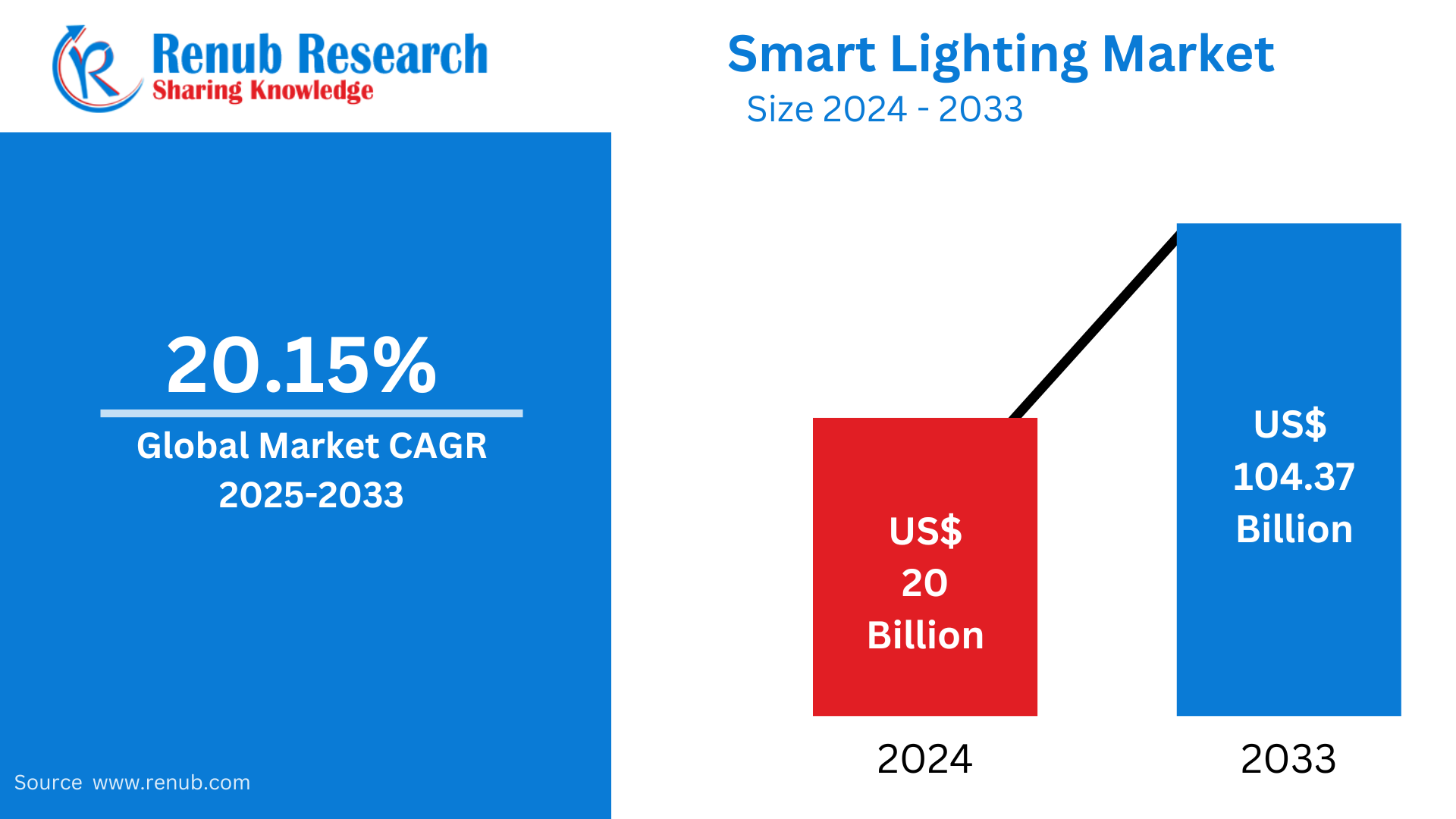Rising Demand for Energy-Efficient and Connected Lighting Solutions Powers Market Growth
According to the latest report by Renub Research, the Smart Lighting Market is expected to grow from USD 20 billion in 2024 to USD 104.37 billion by 2033, registering an impressive CAGR of 20.15% between 2025 and 2033. This substantial growth is fueled by the widespread adoption of energy-efficient lighting systems, the rapid expansion of smart home ecosystems, and continuous advancements in lighting control technologies.
Request sample Report:
https://www.renub.com/request-sample-page.php?gturl=smart-lighting-market-p.php
Smart lighting systems integrate LED technology, sensors, wireless controls, and IoT connectivity to deliver customizable, energy-saving, and automated illumination solutions. These systems are increasingly adopted across residential, commercial, and industrial applications, offering not only energy savings but also enhanced convenience, safety, and aesthetics.
Global Energy Transition Driving Smart Lighting Adoption
As countries commit to net-zero carbon goals, governments worldwide are promoting energy-efficient lighting technologies through incentives, rebates, and regulatory mandates. Smart lighting, which can reduce energy consumption by up to 80% compared to traditional lighting, has emerged as a key enabler in achieving these targets.
In the Asia-Pacific region, urbanization and large-scale infrastructure projects have accelerated smart lighting installations in public spaces, offices, and residential complexes. Similarly, North America and Europe are seeing strong adoption due to the integration of smart lighting with building automation systems.
Key Market Drivers
1. Growing Popularity of Smart Homes
Smart lighting solutions are integral to modern smart homes, allowing users to control brightness, color temperature, and scheduling through mobile apps or voice assistants like Amazon Alexa, Google Assistant, and Apple HomeKit. The convenience, energy savings, and personalization features are driving consumer adoption globally.
2. Technological Advancements
Breakthroughs in IoT, AI, and cloud-based controls have transformed smart lighting from simple motion-sensor lights to highly interactive systems capable of adaptive lighting, energy analytics, and integration with security systems.
3. Government Initiatives and Regulations
Several governments have banned inefficient incandescent and halogen lamps, pushing the adoption of LED and smart lighting systems. Public infrastructure projects—such as smart street lighting—are also creating large-scale opportunities.
4. Energy Cost Savings
Businesses and households are increasingly conscious of electricity bills. Smart lighting systems can automatically adjust brightness based on occupancy and daylight availability, significantly reducing energy expenses.
Smart Lighting Market Segmentation
According to Renub Research, the market is segmented by product type, application, technology, and region.
· By Product Type: Smart bulbs, fixtures, and controls
· By Application: Residential, commercial, industrial, outdoor lighting
· By Technology: Wired, wireless (Wi-Fi, Zigbee, Bluetooth)
· By Region: North America, Europe, Asia-Pacific, Latin America, Middle East & Africa
Asia-Pacific: The Fastest Growing Smart Lighting Market
The Asia-Pacific region is expected to record the highest growth during the forecast period. Factors such as urbanization, government investments in smart cities, and affordable IoT integration are boosting demand. China, Japan, and India are key contributors to regional growth, with large-scale adoption in both residential and commercial projects.
Commercial and Outdoor Applications Lead Revenue Share
While residential adoption is growing steadily, commercial and outdoor applications—including offices, retail spaces, hotels, and public lighting—are projected to account for the largest revenue share. Smart street lighting projects in urban areas are particularly notable for reducing operational costs and enabling data-driven city management.
Industry Challenges
Despite strong growth prospects, the market faces challenges such as:
· High initial installation costs
· Interoperability issues between different brands and protocols
· Cybersecurity concerns for connected devices
However, as technology advances and economies of scale reduce costs, these barriers are expected to diminish.
Future Outlook
The next decade will see smart lighting systems evolve beyond illumination. Integration with smart building management, energy analytics platforms, and urban IoT ecosystems will open new revenue streams. The use of AI-powered adaptive lighting will further personalize user experiences and optimize energy efficiency.
For in-depth insights and detailed market breakdown, you can read the full report here:
? Smart Lighting Market Report – Renub Research
New Publish Report:
10 Frequently Asked Questions (FAQs)
1. What is the current size of the Smart Lighting Market?
The market was valued at USD 20 billion in 2024.
2. What is the projected market size by 2033?
It is expected to reach USD 104.37 billion by 2033.
3. What is the growth rate of the Smart Lighting Market?
The CAGR is estimated at 20.15% from 2025 to 2033.
4. What are the main factors driving market growth?
Energy efficiency, smart home adoption, technological advancements, and government initiatives.
5. Which region is expected to grow the fastest?
The Asia-Pacific region, driven by smart city projects and urbanization.
6. What are the major applications of smart lighting?
Residential, commercial, industrial, and outdoor/public lighting.
7. What technologies are used in smart lighting systems?
Wired systems and wireless technologies such as Wi-Fi, Zigbee, and Bluetooth.
8. What challenges does the smart lighting industry face?
High initial costs, interoperability issues, and cybersecurity risks.
9. How does smart lighting save energy?
Through automated dimming, scheduling, occupancy sensing, and daylight harvesting.
10. Who are the primary users of smart lighting systems?
Homeowners, commercial building operators, municipalities, and industrial facility managers.
About the Company
Renub Research is a Market Research and Consulting Company with more than 15 years of experience, especially in international Business-to-Business Research, Surveys, and Consulting. We provide a wide range of business research solutions that help companies make better business decisions. We partner with clients across all sectors and regions to identify their highest-value opportunities, address their most critical challenges, and transform their businesses. Our wide clientele includes key players in Healthcare, Travel & Tourism, Food & Beverages, Power & Energy, Information Technology, Telecom & Internet, Chemicals, Logistics & Automotive, Consumer Goods & Retail, Building & Construction, and Agriculture. Our core team comprises experienced professionals with graduate, postgraduate, and Ph.D. qualifications in Finance, Marketing, Human Resources, Bio-Technology, Medicine, Information Technology, Environmental Science, and more.
Media Contact
Company Name: Renub Research
Contact Person: Rajat Gupta, Marketing Manager
Phone No: +91-120-421-9822 (IND) | +1-478-202-3244 (USA)
Email: rajat@renub.com



